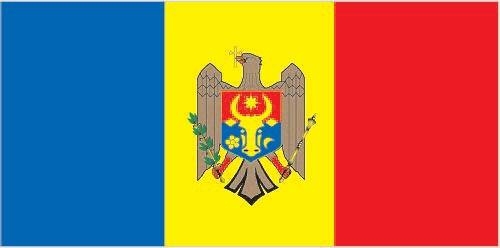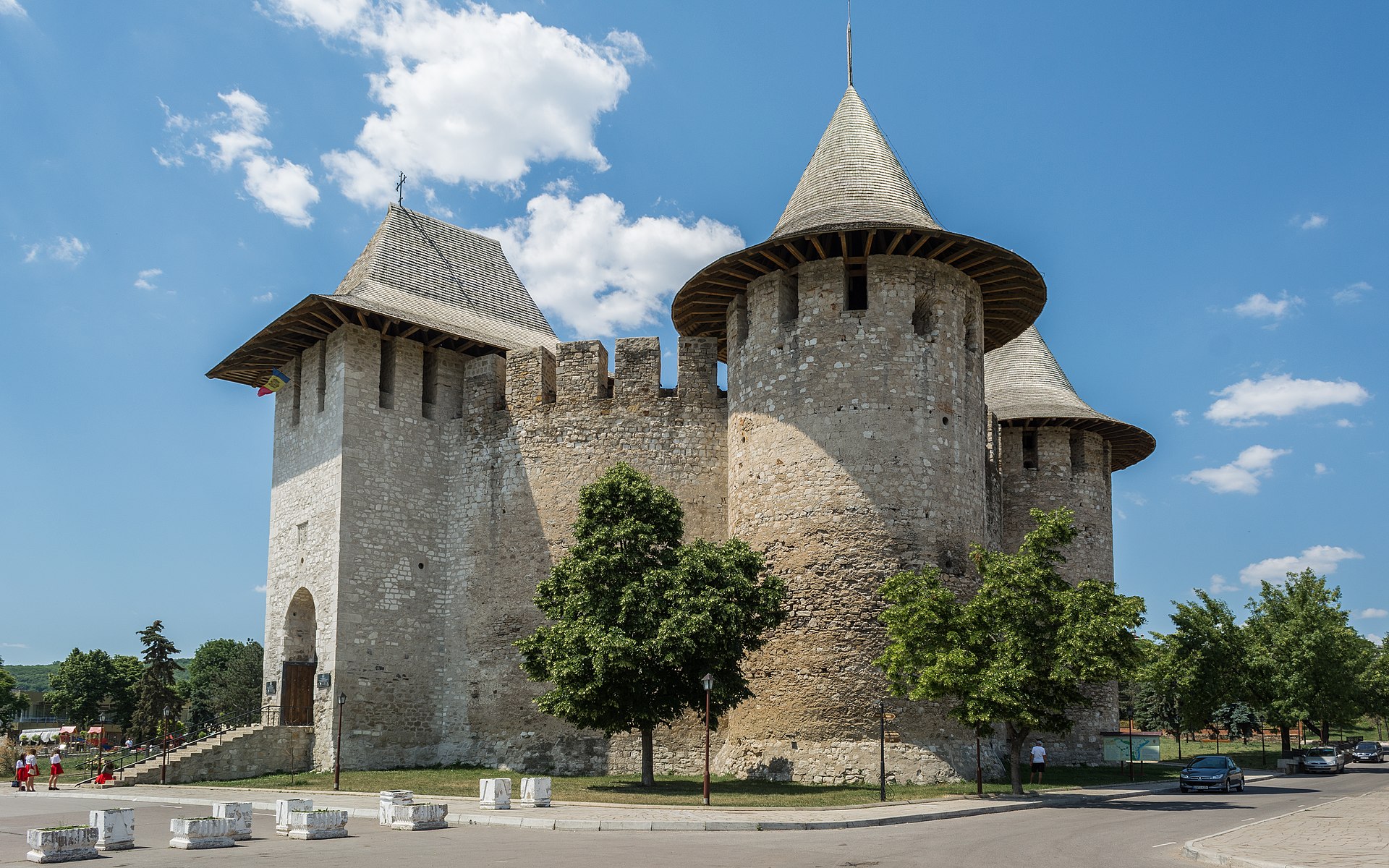92 Moldova

Three equal vertical bands of Prussian blue (hoist side), chrome yellow, and vermilion red. Emblem in center of flag is of a Roman eagle of dark gold (brown) outlined in black with a red beak and talons carrying a yellow cross in its beak and a green olive branch in its right talons and a yellow scepter in its left talons. On its breast is a shield divided horizontally red over blue with a stylized aurochs head, star, rose, and crescent all in black-outlined yellow. Based on the color scheme of the flag of Romania – with which Moldova shares a history and culture – but Moldova’s blue band is lighter. The reverse of the flag displays a mirrored image of the coat of arms.
Flag courtesy of the CIA World Factbook

Map courtesy of the CIA World Factbook

Built during the reign of Stephen the Great, several authors believed the Soroca Fort was constructed on the site of a former Genoese fortress named Olhionia.
Government
According to Britannica, a new constitution, which replaced the 1978 document that had provided for a Soviet-style government structure, was approved by the Moldovan parliament in July 1994 and promulgated on August 27 of that year. Describing the republic as a “sovereign, independent” state in which “justice and political pluralism” are guaranteed, this constitution formally established a unicameral parliament whose members are directly elected to four-year terms. By secret ballot they elect the president, who serves as the head of state, to a four-year term. The president shares executive power with the Council of Ministers (cabinet), which is led by the prime minister, who is designated by the president (after consultation with the parliamentary majority) and approved by the parliament. The council is responsible for implementing the domestic and foreign policy of the state.
Following the collapse of the Soviet Union, the Gagauz in the south and Russians east of the Dniester River declared their own independent republics. The Moldovan government addressed the desires of the Gagauz in January 1995 by establishing an autonomous administrative region known as Găgăuzia. Its capital is in Comrat, where a governor (bașkan), an executive committee, and a legislature sit (foreign policy, defense, and monetary issues in Găgăuzia are still under the control of the Moldovan government). Neither the Moldovan government nor the international community has recognized the independent republic of Transdniestria (Pridnestrovie; Transnistria), whose name is derived from its location beyond (on the eastern side of) the Dniester River. Under Transdniestria’s constitution its president also serves as prime minister, and there is a unicameral legislature. The self-proclaimed republic also has its own flag and anthem. In response to the region’s aspirations, the 1994 Moldovan constitution had authorized “special status” for the semiautonomous territory of Transdniestria, as it had for Găgăuzia. This offer was rejected by Transdniestria’s government, and an overwhelming majority of Transdniestrian residents voted for independence in a 2006 referendum (though the subsequent declaration of independence was not recognized elsewhere). Russia maintained a force of some 1,500 troops in Transdniestria.
Following Soviet rule, Moldova was reorganized into județ (counties), the municipality of Chișinău, and the autonomous region of Găgăuzia. In 2003 the country was restructured again, with previous divisions replaced by raione (districts), municipii (municipalities; including Chișinău), and Găgăuzia. At a more local level, Moldova is administered by elected town and village councils and mayors; their activities are coordinated by district councils, which also are elected.
The judicial system comprises the Supreme Court of Justice (with members appointed by the parliament), a Court of Appeal, and lower courts (whose members are appointed by the president). The Higher Magistrates’ Council nominates judges and oversees their transfer and promotion.
Moldova Civil Aviation Authority
The Moldova Civil Aviation Authority is an administrative authority for certification, supervision and control in the field of civil aviation, which has the status of a legal person of public law with a form of legal organization of the Agency, financed from the state budget, based in Chisinau municipality, and is subordinated to the Ministry of Economy and Infrastructure. The Authority’s mission is to implement civil aviation policies and to monitor compliance by natural and legal persons with legislation in this area to ensure flight safety, aeronautical safety, consumer protection and occupational safety.
Airspace
SkyVector – Google Maps – ADS-B Exchange
ICAO countries publish an Aeronautical Information Publication (AIP). This document is divided into three parts: General (GEN), En Route (ENR) and Aerodromes (AD). ENR 1.4 details the types of airspace classes they chose to adopt from classes A through G.
Drone Regulations
Advanced Air Mobility (AAM) Regulations & Policies
None found by the author.
However, should you, the reader, happen to stumble across something to the contrary, please email the author at FISHE5CA@erau.edu and you may be mentioned in the ACKNOWLEDGEMENTS section of this book by way of thanks for contributing to this free eBook!
Advanced Air Mobility (AAM) News
None found by the author.
However, should you, the reader, happen to stumble across something to the contrary, please email the author at FISHE5CA@erau.edu and you may be mentioned in the ACKNOWLEDGEMENTS section of this book by way of thanks for contributing to this free eBook!
Short Essay Questions
Scenario-Based Question
You have been hired by a Drone Startup Company. Your boss has immediately assigned this job to you.
They need you to prepare a one-page memo detailing the legalities of using a drone to film the Soroca Fort, pictured above.
They need you to mention any national laws and local ordinances.
They specifically want to know what airspace (insert pictures) you will be operating in and whether or not you need an airspace authorization.
Does it matter whether or not you are a citizen of the country?
Lastly, there is a bonus for you if, as you scroll through this chapter, you find any typos or broken links!
Short Essay Questions
- What are the drone categories?
- How is registration addressed?
- How is remote ID addressed?
- What are the model aircraft rules?
- What are the commercial drone rules?
- Are there waivers or exemptions to the rules? If so, for what?
- Would you share a link to an interactive airspace map?
- How is BVLOS addressed?
- How can you fly drones at night?
- How can you fly drones over people?
- Where do you find drone NOTAMs?
- What are the rules for drone maintenance?
- What are the rules for an SMS program?
- What are some unique rules not mentioned above?
- What are the C-UAS rules?
- What are the AAM rules?

